Analysis of Operations Management at Adelaide Brighton Cement Company
VerifiedAdded on 2023/06/03
|24
|5227
|315
Report
AI Summary
This report provides a comprehensive analysis of logistics and operations management, specifically focusing on the Adelaide Brighton Cement Company. The report begins with an executive summary and table of contents, followed by an introduction that outlines the shift away from traditional manufacturing techniques. The report examines the company's background, including its history and evolution. It then delves into the quality management strategy employed by ABC, detailing the company's approach to quality, including a review of sales strategies and management tactics. A literature review supports the analysis, with articles exploring quality management systems, total quality management, and quality as a strategic support for businesses. A House of Quality (HoQ) is developed for the cement product, analyzing customer needs and product attributes. The second part of the report focuses on process strategy, including an overview of the repetitive focus and layout strategy. It includes a brief literature review on process and product modeling and configuration, and suggests improvements for the production of cement. The report concludes with a discussion and conclusions section, offering insights into the company's operations and recommendations for improvement.
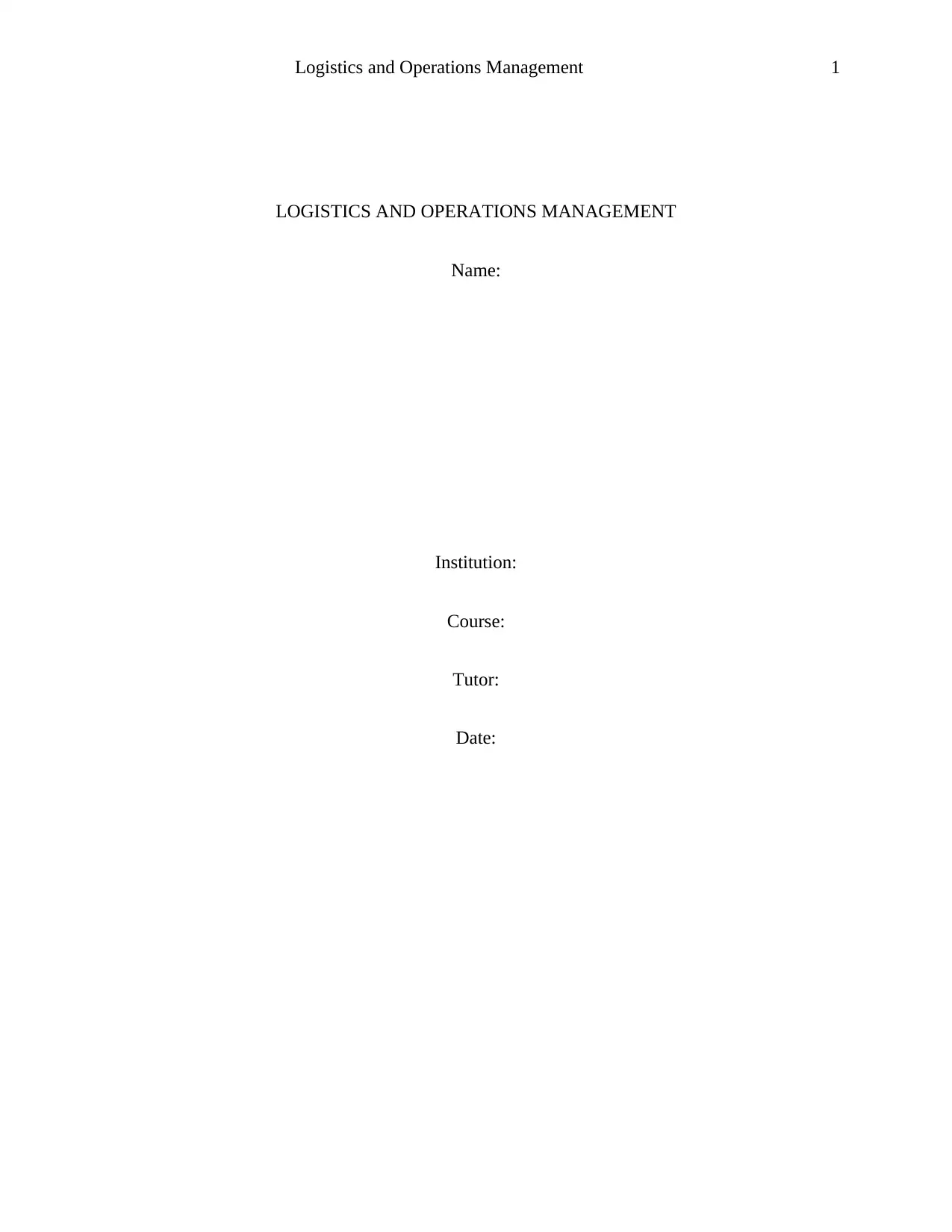
Logistics and Operations Management 1
LOGISTICS AND OPERATIONS MANAGEMENT
Name:
Institution:
Course:
Tutor:
Date:
LOGISTICS AND OPERATIONS MANAGEMENT
Name:
Institution:
Course:
Tutor:
Date:
Paraphrase This Document
Need a fresh take? Get an instant paraphrase of this document with our AI Paraphraser
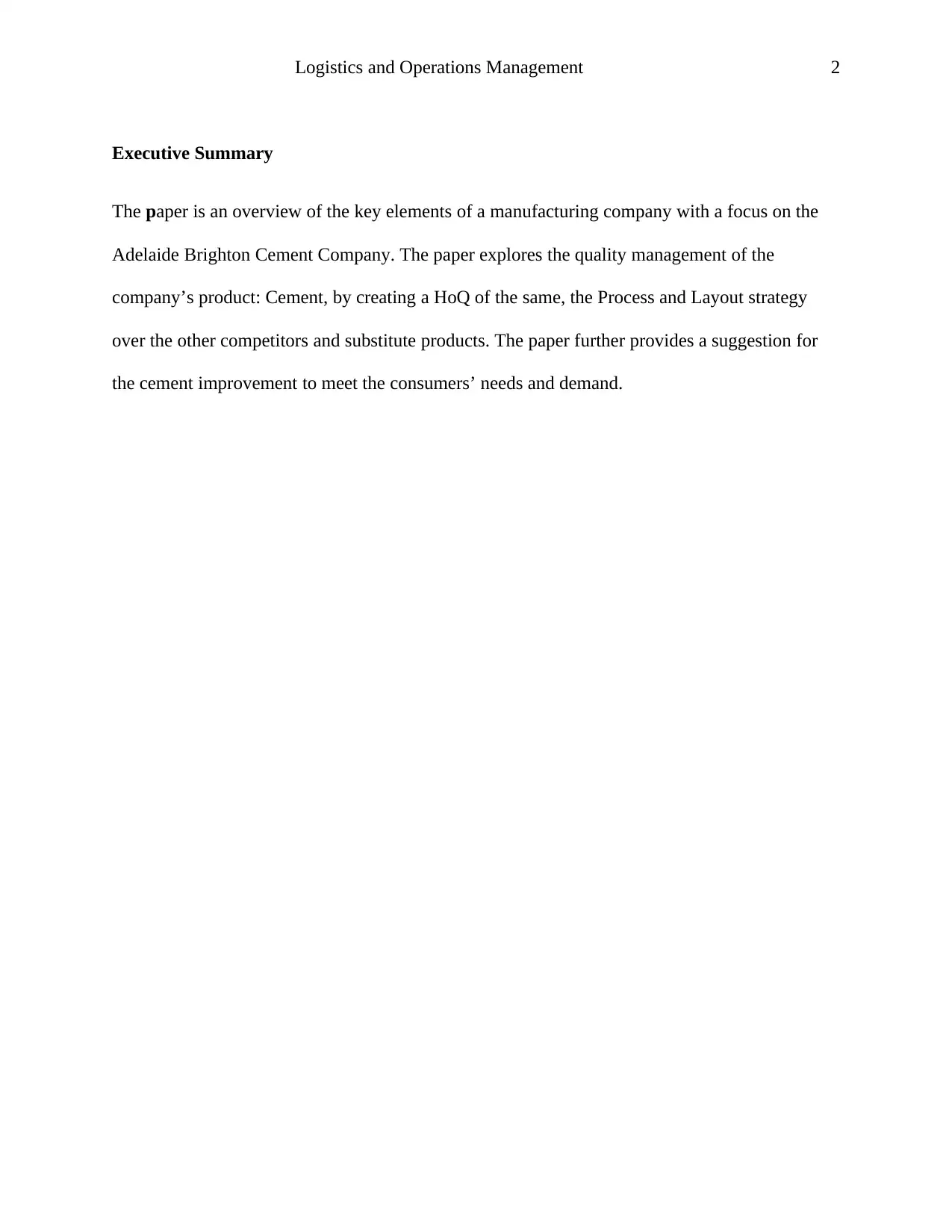
Logistics and Operations Management 2
Executive Summary
The paper is an overview of the key elements of a manufacturing company with a focus on the
Adelaide Brighton Cement Company. The paper explores the quality management of the
company’s product: Cement, by creating a HoQ of the same, the Process and Layout strategy
over the other competitors and substitute products. The paper further provides a suggestion for
the cement improvement to meet the consumers’ needs and demand.
Executive Summary
The paper is an overview of the key elements of a manufacturing company with a focus on the
Adelaide Brighton Cement Company. The paper explores the quality management of the
company’s product: Cement, by creating a HoQ of the same, the Process and Layout strategy
over the other competitors and substitute products. The paper further provides a suggestion for
the cement improvement to meet the consumers’ needs and demand.
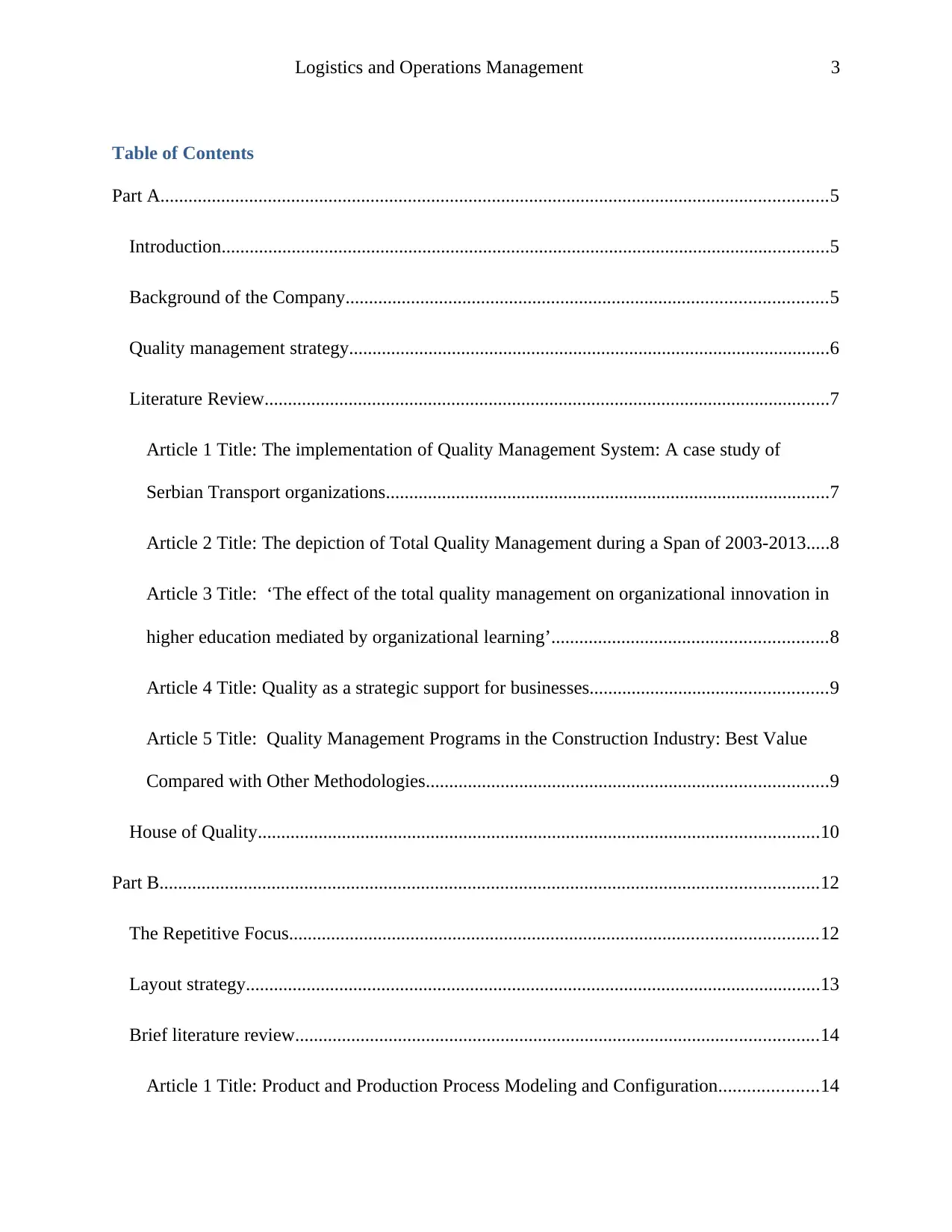
Logistics and Operations Management 3
Table of Contents
Part A...............................................................................................................................................5
Introduction..................................................................................................................................5
Background of the Company.......................................................................................................5
Quality management strategy.......................................................................................................6
Literature Review.........................................................................................................................7
Article 1 Title: The implementation of Quality Management System: A case study of
Serbian Transport organizations...............................................................................................7
Article 2 Title: The depiction of Total Quality Management during a Span of 2003-2013.....8
Article 3 Title: ‘The effect of the total quality management on organizational innovation in
higher education mediated by organizational learning’...........................................................8
Article 4 Title: Quality as a strategic support for businesses...................................................9
Article 5 Title: Quality Management Programs in the Construction Industry: Best Value
Compared with Other Methodologies......................................................................................9
House of Quality........................................................................................................................10
Part B.............................................................................................................................................12
The Repetitive Focus.................................................................................................................12
Layout strategy...........................................................................................................................13
Brief literature review................................................................................................................14
Article 1 Title: Product and Production Process Modeling and Configuration.....................14
Table of Contents
Part A...............................................................................................................................................5
Introduction..................................................................................................................................5
Background of the Company.......................................................................................................5
Quality management strategy.......................................................................................................6
Literature Review.........................................................................................................................7
Article 1 Title: The implementation of Quality Management System: A case study of
Serbian Transport organizations...............................................................................................7
Article 2 Title: The depiction of Total Quality Management during a Span of 2003-2013.....8
Article 3 Title: ‘The effect of the total quality management on organizational innovation in
higher education mediated by organizational learning’...........................................................8
Article 4 Title: Quality as a strategic support for businesses...................................................9
Article 5 Title: Quality Management Programs in the Construction Industry: Best Value
Compared with Other Methodologies......................................................................................9
House of Quality........................................................................................................................10
Part B.............................................................................................................................................12
The Repetitive Focus.................................................................................................................12
Layout strategy...........................................................................................................................13
Brief literature review................................................................................................................14
Article 1 Title: Product and Production Process Modeling and Configuration.....................14
⊘ This is a preview!⊘
Do you want full access?
Subscribe today to unlock all pages.

Trusted by 1+ million students worldwide
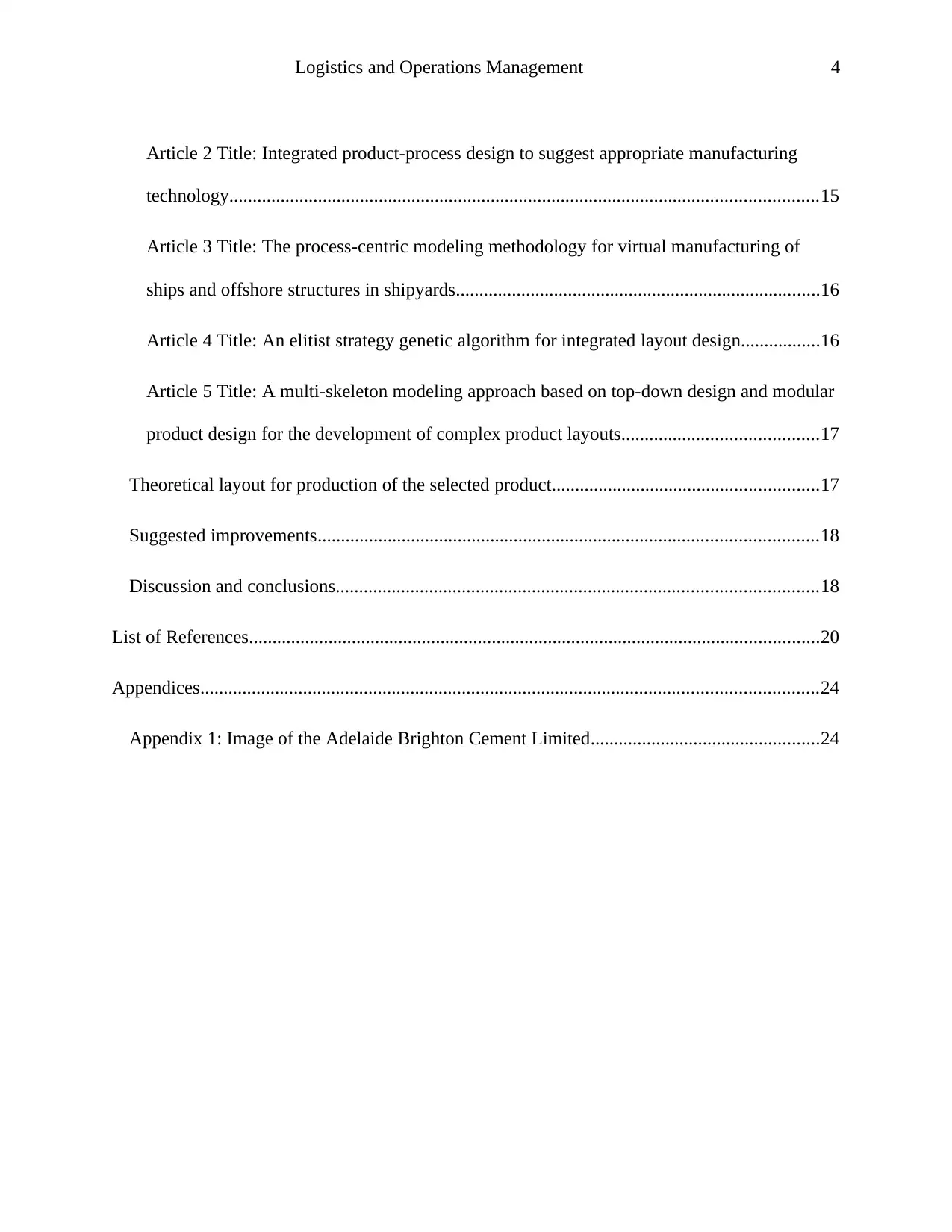
Logistics and Operations Management 4
Article 2 Title: Integrated product-process design to suggest appropriate manufacturing
technology..............................................................................................................................15
Article 3 Title: The process-centric modeling methodology for virtual manufacturing of
ships and offshore structures in shipyards..............................................................................16
Article 4 Title: An elitist strategy genetic algorithm for integrated layout design.................16
Article 5 Title: A multi-skeleton modeling approach based on top-down design and modular
product design for the development of complex product layouts..........................................17
Theoretical layout for production of the selected product.........................................................17
Suggested improvements...........................................................................................................18
Discussion and conclusions.......................................................................................................18
List of References..........................................................................................................................20
Appendices....................................................................................................................................24
Appendix 1: Image of the Adelaide Brighton Cement Limited.................................................24
Article 2 Title: Integrated product-process design to suggest appropriate manufacturing
technology..............................................................................................................................15
Article 3 Title: The process-centric modeling methodology for virtual manufacturing of
ships and offshore structures in shipyards..............................................................................16
Article 4 Title: An elitist strategy genetic algorithm for integrated layout design.................16
Article 5 Title: A multi-skeleton modeling approach based on top-down design and modular
product design for the development of complex product layouts..........................................17
Theoretical layout for production of the selected product.........................................................17
Suggested improvements...........................................................................................................18
Discussion and conclusions.......................................................................................................18
List of References..........................................................................................................................20
Appendices....................................................................................................................................24
Appendix 1: Image of the Adelaide Brighton Cement Limited.................................................24
Paraphrase This Document
Need a fresh take? Get an instant paraphrase of this document with our AI Paraphraser
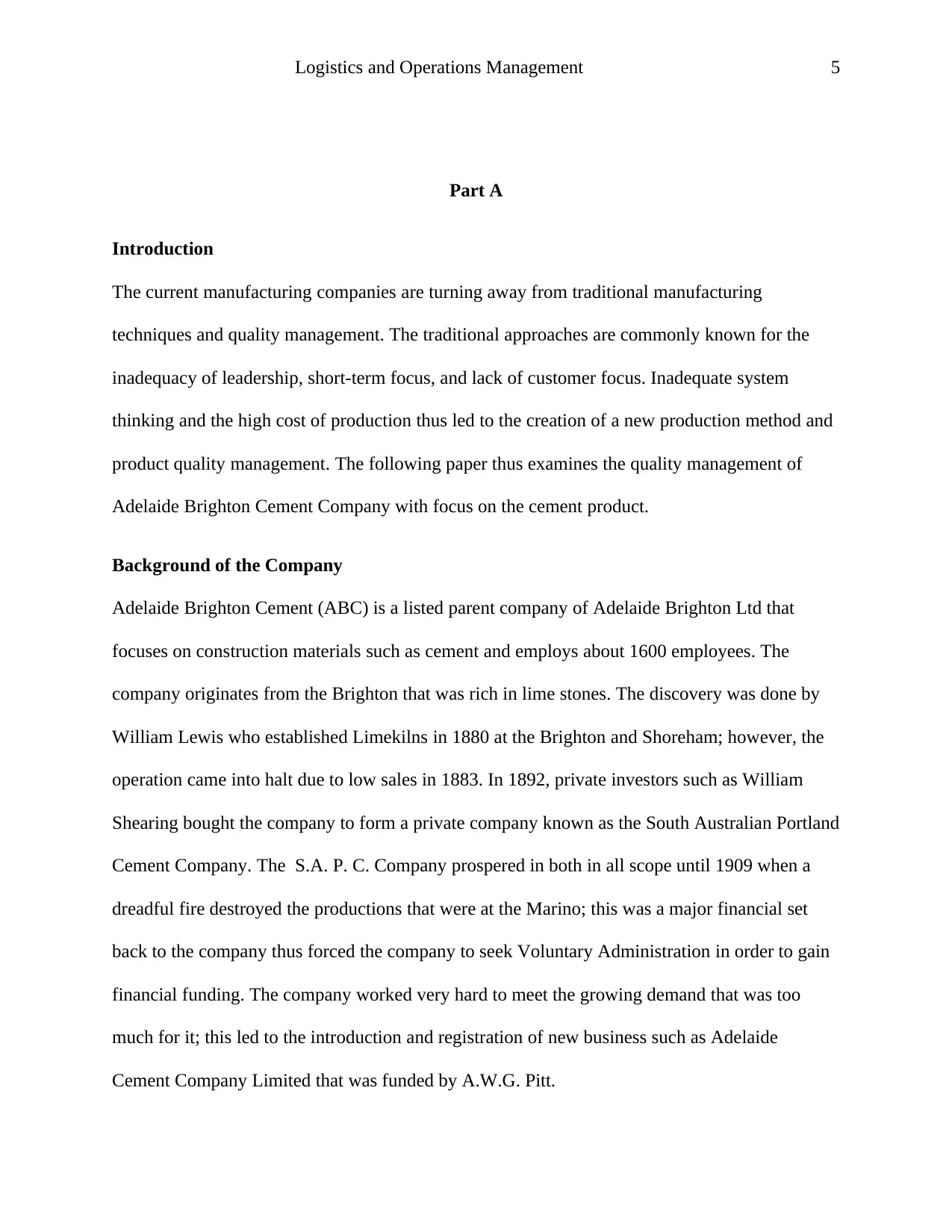
Logistics and Operations Management 5
Part A
Introduction
The current manufacturing companies are turning away from traditional manufacturing
techniques and quality management. The traditional approaches are commonly known for the
inadequacy of leadership, short-term focus, and lack of customer focus. Inadequate system
thinking and the high cost of production thus led to the creation of a new production method and
product quality management. The following paper thus examines the quality management of
Adelaide Brighton Cement Company with focus on the cement product.
Background of the Company
Adelaide Brighton Cement (ABC) is a listed parent company of Adelaide Brighton Ltd that
focuses on construction materials such as cement and employs about 1600 employees. The
company originates from the Brighton that was rich in lime stones. The discovery was done by
William Lewis who established Limekilns in 1880 at the Brighton and Shoreham; however, the
operation came into halt due to low sales in 1883. In 1892, private investors such as William
Shearing bought the company to form a private company known as the South Australian Portland
Cement Company. The S.A. P. C. Company prospered in both in all scope until 1909 when a
dreadful fire destroyed the productions that were at the Marino; this was a major financial set
back to the company thus forced the company to seek Voluntary Administration in order to gain
financial funding. The company worked very hard to meet the growing demand that was too
much for it; this led to the introduction and registration of new business such as Adelaide
Cement Company Limited that was funded by A.W.G. Pitt.
Part A
Introduction
The current manufacturing companies are turning away from traditional manufacturing
techniques and quality management. The traditional approaches are commonly known for the
inadequacy of leadership, short-term focus, and lack of customer focus. Inadequate system
thinking and the high cost of production thus led to the creation of a new production method and
product quality management. The following paper thus examines the quality management of
Adelaide Brighton Cement Company with focus on the cement product.
Background of the Company
Adelaide Brighton Cement (ABC) is a listed parent company of Adelaide Brighton Ltd that
focuses on construction materials such as cement and employs about 1600 employees. The
company originates from the Brighton that was rich in lime stones. The discovery was done by
William Lewis who established Limekilns in 1880 at the Brighton and Shoreham; however, the
operation came into halt due to low sales in 1883. In 1892, private investors such as William
Shearing bought the company to form a private company known as the South Australian Portland
Cement Company. The S.A. P. C. Company prospered in both in all scope until 1909 when a
dreadful fire destroyed the productions that were at the Marino; this was a major financial set
back to the company thus forced the company to seek Voluntary Administration in order to gain
financial funding. The company worked very hard to meet the growing demand that was too
much for it; this led to the introduction and registration of new business such as Adelaide
Cement Company Limited that was funded by A.W.G. Pitt.
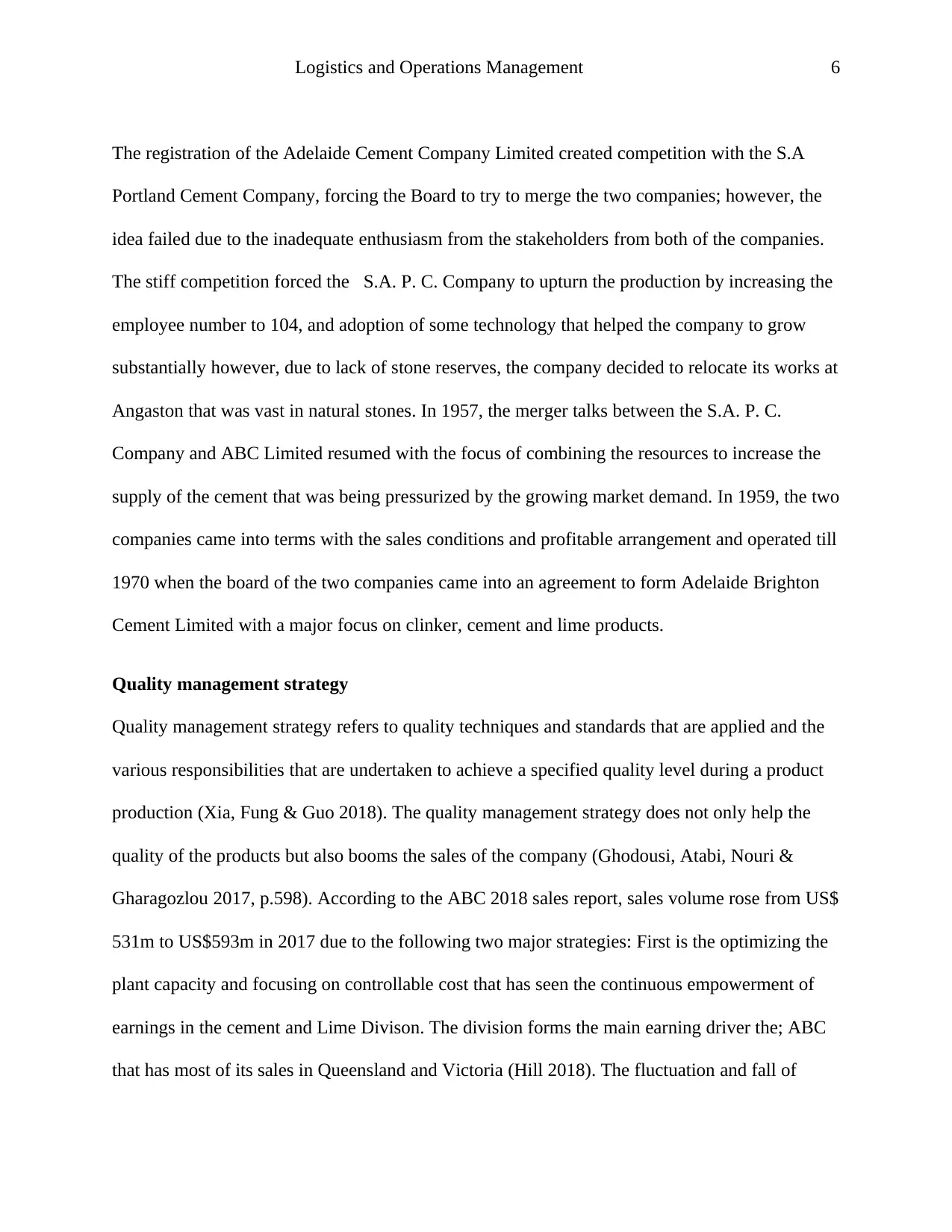
Logistics and Operations Management 6
The registration of the Adelaide Cement Company Limited created competition with the S.A
Portland Cement Company, forcing the Board to try to merge the two companies; however, the
idea failed due to the inadequate enthusiasm from the stakeholders from both of the companies.
The stiff competition forced the S.A. P. C. Company to upturn the production by increasing the
employee number to 104, and adoption of some technology that helped the company to grow
substantially however, due to lack of stone reserves, the company decided to relocate its works at
Angaston that was vast in natural stones. In 1957, the merger talks between the S.A. P. C.
Company and ABC Limited resumed with the focus of combining the resources to increase the
supply of the cement that was being pressurized by the growing market demand. In 1959, the two
companies came into terms with the sales conditions and profitable arrangement and operated till
1970 when the board of the two companies came into an agreement to form Adelaide Brighton
Cement Limited with a major focus on clinker, cement and lime products.
Quality management strategy
Quality management strategy refers to quality techniques and standards that are applied and the
various responsibilities that are undertaken to achieve a specified quality level during a product
production (Xia, Fung & Guo 2018). The quality management strategy does not only help the
quality of the products but also booms the sales of the company (Ghodousi, Atabi, Nouri &
Gharagozlou 2017, p.598). According to the ABC 2018 sales report, sales volume rose from US$
531m to US$593m in 2017 due to the following two major strategies: First is the optimizing the
plant capacity and focusing on controllable cost that has seen the continuous empowerment of
earnings in the cement and Lime Divison. The division forms the main earning driver the; ABC
that has most of its sales in Queensland and Victoria (Hill 2018). The fluctuation and fall of
The registration of the Adelaide Cement Company Limited created competition with the S.A
Portland Cement Company, forcing the Board to try to merge the two companies; however, the
idea failed due to the inadequate enthusiasm from the stakeholders from both of the companies.
The stiff competition forced the S.A. P. C. Company to upturn the production by increasing the
employee number to 104, and adoption of some technology that helped the company to grow
substantially however, due to lack of stone reserves, the company decided to relocate its works at
Angaston that was vast in natural stones. In 1957, the merger talks between the S.A. P. C.
Company and ABC Limited resumed with the focus of combining the resources to increase the
supply of the cement that was being pressurized by the growing market demand. In 1959, the two
companies came into terms with the sales conditions and profitable arrangement and operated till
1970 when the board of the two companies came into an agreement to form Adelaide Brighton
Cement Limited with a major focus on clinker, cement and lime products.
Quality management strategy
Quality management strategy refers to quality techniques and standards that are applied and the
various responsibilities that are undertaken to achieve a specified quality level during a product
production (Xia, Fung & Guo 2018). The quality management strategy does not only help the
quality of the products but also booms the sales of the company (Ghodousi, Atabi, Nouri &
Gharagozlou 2017, p.598). According to the ABC 2018 sales report, sales volume rose from US$
531m to US$593m in 2017 due to the following two major strategies: First is the optimizing the
plant capacity and focusing on controllable cost that has seen the continuous empowerment of
earnings in the cement and Lime Divison. The division forms the main earning driver the; ABC
that has most of its sales in Queensland and Victoria (Hill 2018). The fluctuation and fall of
⊘ This is a preview!⊘
Do you want full access?
Subscribe today to unlock all pages.

Trusted by 1+ million students worldwide
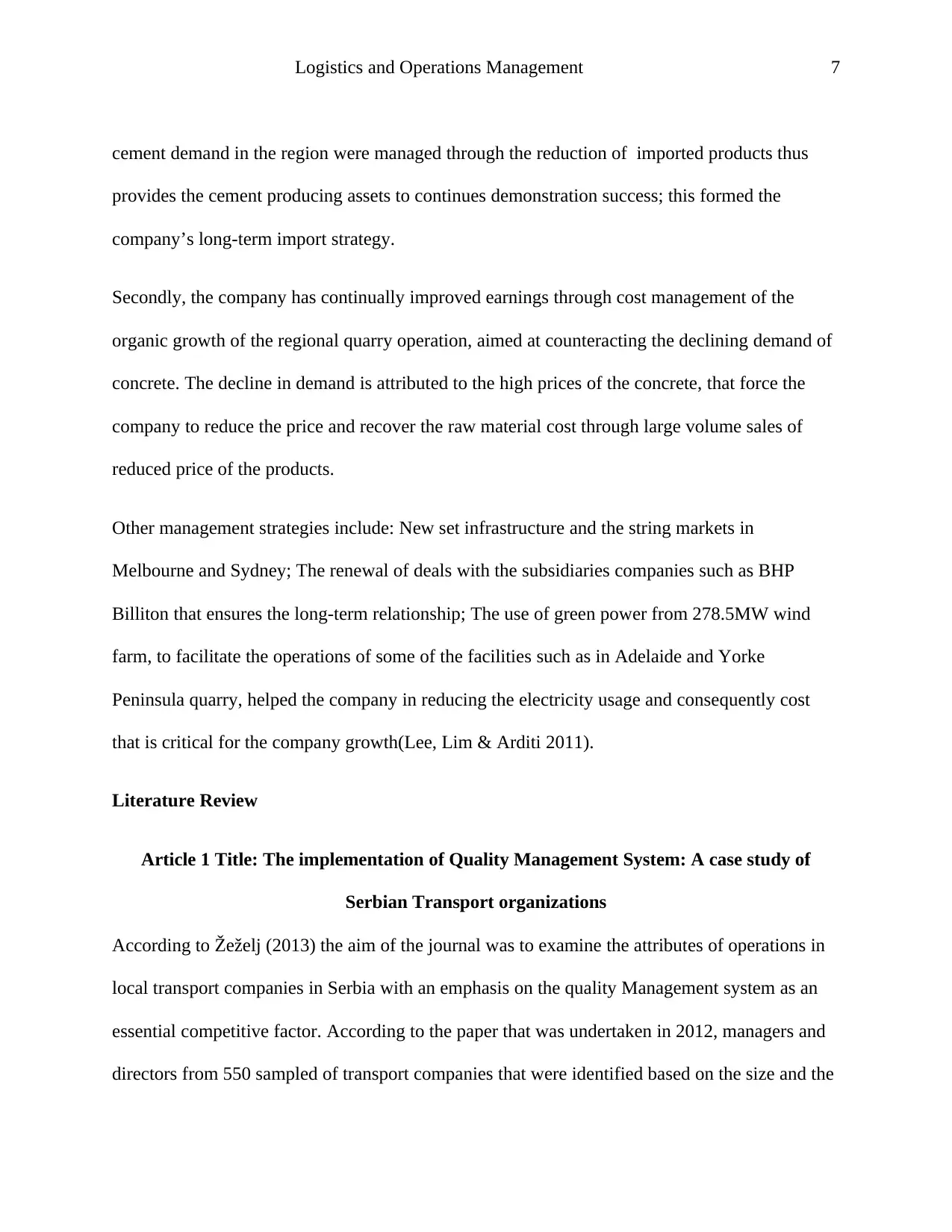
Logistics and Operations Management 7
cement demand in the region were managed through the reduction of imported products thus
provides the cement producing assets to continues demonstration success; this formed the
company’s long-term import strategy.
Secondly, the company has continually improved earnings through cost management of the
organic growth of the regional quarry operation, aimed at counteracting the declining demand of
concrete. The decline in demand is attributed to the high prices of the concrete, that force the
company to reduce the price and recover the raw material cost through large volume sales of
reduced price of the products.
Other management strategies include: New set infrastructure and the string markets in
Melbourne and Sydney; The renewal of deals with the subsidiaries companies such as BHP
Billiton that ensures the long-term relationship; The use of green power from 278.5MW wind
farm, to facilitate the operations of some of the facilities such as in Adelaide and Yorke
Peninsula quarry, helped the company in reducing the electricity usage and consequently cost
that is critical for the company growth(Lee, Lim & Arditi 2011).
Literature Review
Article 1 Title: The implementation of Quality Management System: A case study of
Serbian Transport organizations
According to Žeželj (2013) the aim of the journal was to examine the attributes of operations in
local transport companies in Serbia with an emphasis on the quality Management system as an
essential competitive factor. According to the paper that was undertaken in 2012, managers and
directors from 550 sampled of transport companies that were identified based on the size and the
cement demand in the region were managed through the reduction of imported products thus
provides the cement producing assets to continues demonstration success; this formed the
company’s long-term import strategy.
Secondly, the company has continually improved earnings through cost management of the
organic growth of the regional quarry operation, aimed at counteracting the declining demand of
concrete. The decline in demand is attributed to the high prices of the concrete, that force the
company to reduce the price and recover the raw material cost through large volume sales of
reduced price of the products.
Other management strategies include: New set infrastructure and the string markets in
Melbourne and Sydney; The renewal of deals with the subsidiaries companies such as BHP
Billiton that ensures the long-term relationship; The use of green power from 278.5MW wind
farm, to facilitate the operations of some of the facilities such as in Adelaide and Yorke
Peninsula quarry, helped the company in reducing the electricity usage and consequently cost
that is critical for the company growth(Lee, Lim & Arditi 2011).
Literature Review
Article 1 Title: The implementation of Quality Management System: A case study of
Serbian Transport organizations
According to Žeželj (2013) the aim of the journal was to examine the attributes of operations in
local transport companies in Serbia with an emphasis on the quality Management system as an
essential competitive factor. According to the paper that was undertaken in 2012, managers and
directors from 550 sampled of transport companies that were identified based on the size and the
Paraphrase This Document
Need a fresh take? Get an instant paraphrase of this document with our AI Paraphraser
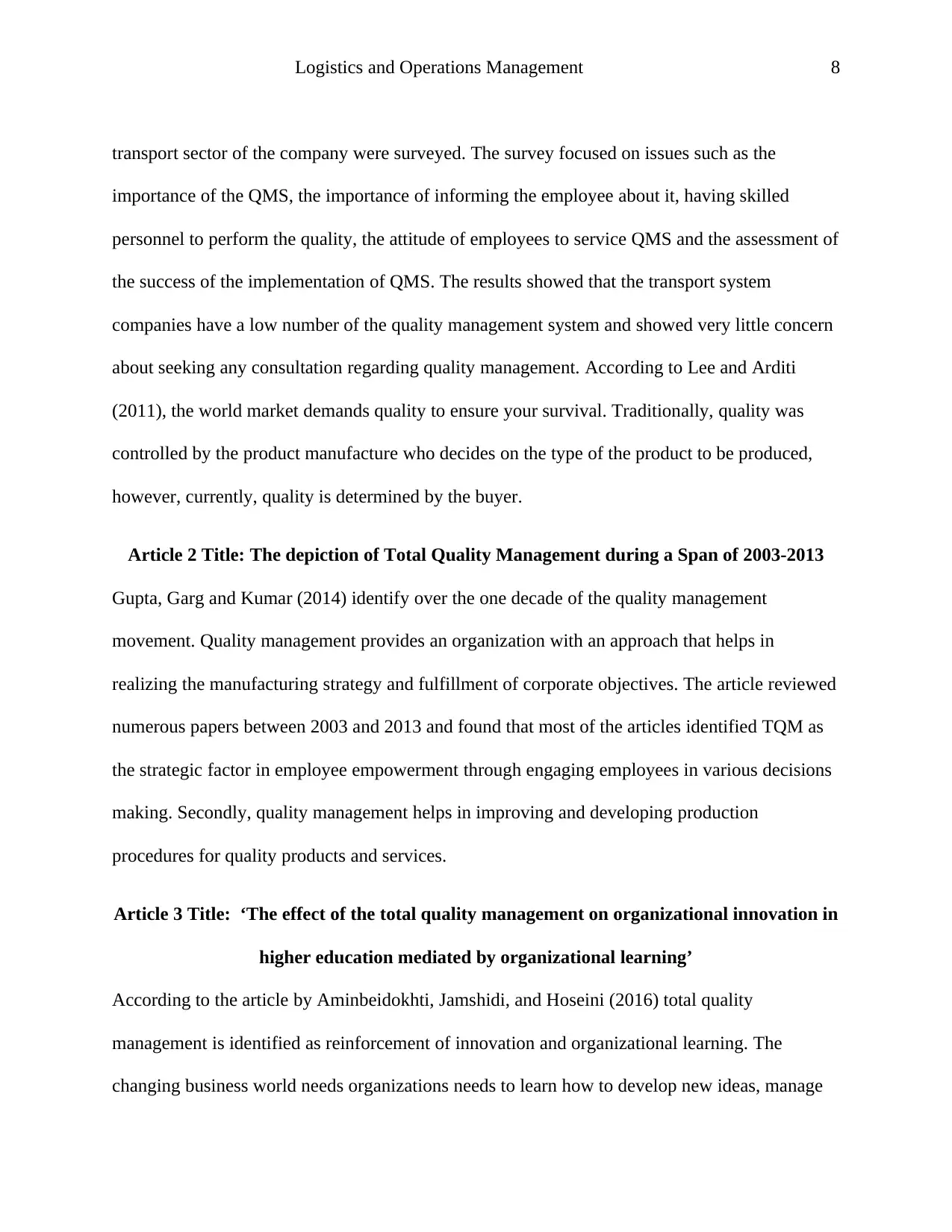
Logistics and Operations Management 8
transport sector of the company were surveyed. The survey focused on issues such as the
importance of the QMS, the importance of informing the employee about it, having skilled
personnel to perform the quality, the attitude of employees to service QMS and the assessment of
the success of the implementation of QMS. The results showed that the transport system
companies have a low number of the quality management system and showed very little concern
about seeking any consultation regarding quality management. According to Lee and Arditi
(2011), the world market demands quality to ensure your survival. Traditionally, quality was
controlled by the product manufacture who decides on the type of the product to be produced,
however, currently, quality is determined by the buyer.
Article 2 Title: The depiction of Total Quality Management during a Span of 2003-2013
Gupta, Garg and Kumar (2014) identify over the one decade of the quality management
movement. Quality management provides an organization with an approach that helps in
realizing the manufacturing strategy and fulfillment of corporate objectives. The article reviewed
numerous papers between 2003 and 2013 and found that most of the articles identified TQM as
the strategic factor in employee empowerment through engaging employees in various decisions
making. Secondly, quality management helps in improving and developing production
procedures for quality products and services.
Article 3 Title: ‘The effect of the total quality management on organizational innovation in
higher education mediated by organizational learning’
According to the article by Aminbeidokhti, Jamshidi, and Hoseini (2016) total quality
management is identified as reinforcement of innovation and organizational learning. The
changing business world needs organizations needs to learn how to develop new ideas, manage
transport sector of the company were surveyed. The survey focused on issues such as the
importance of the QMS, the importance of informing the employee about it, having skilled
personnel to perform the quality, the attitude of employees to service QMS and the assessment of
the success of the implementation of QMS. The results showed that the transport system
companies have a low number of the quality management system and showed very little concern
about seeking any consultation regarding quality management. According to Lee and Arditi
(2011), the world market demands quality to ensure your survival. Traditionally, quality was
controlled by the product manufacture who decides on the type of the product to be produced,
however, currently, quality is determined by the buyer.
Article 2 Title: The depiction of Total Quality Management during a Span of 2003-2013
Gupta, Garg and Kumar (2014) identify over the one decade of the quality management
movement. Quality management provides an organization with an approach that helps in
realizing the manufacturing strategy and fulfillment of corporate objectives. The article reviewed
numerous papers between 2003 and 2013 and found that most of the articles identified TQM as
the strategic factor in employee empowerment through engaging employees in various decisions
making. Secondly, quality management helps in improving and developing production
procedures for quality products and services.
Article 3 Title: ‘The effect of the total quality management on organizational innovation in
higher education mediated by organizational learning’
According to the article by Aminbeidokhti, Jamshidi, and Hoseini (2016) total quality
management is identified as reinforcement of innovation and organizational learning. The
changing business world needs organizations needs to learn how to develop new ideas, manage
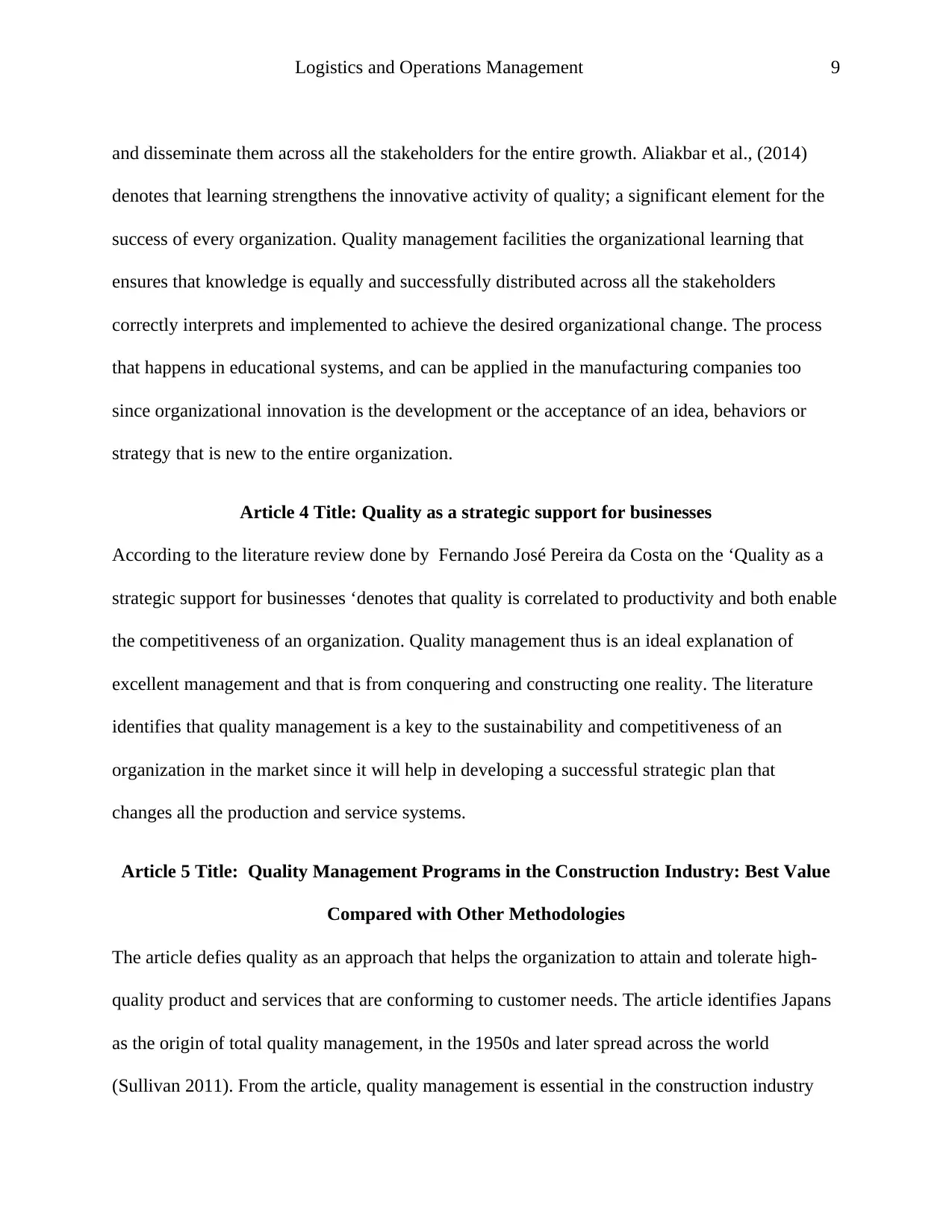
Logistics and Operations Management 9
and disseminate them across all the stakeholders for the entire growth. Aliakbar et al., (2014)
denotes that learning strengthens the innovative activity of quality; a significant element for the
success of every organization. Quality management facilities the organizational learning that
ensures that knowledge is equally and successfully distributed across all the stakeholders
correctly interprets and implemented to achieve the desired organizational change. The process
that happens in educational systems, and can be applied in the manufacturing companies too
since organizational innovation is the development or the acceptance of an idea, behaviors or
strategy that is new to the entire organization.
Article 4 Title: Quality as a strategic support for businesses
According to the literature review done by Fernando José Pereira da Costa on the ‘Quality as a
strategic support for businesses ‘denotes that quality is correlated to productivity and both enable
the competitiveness of an organization. Quality management thus is an ideal explanation of
excellent management and that is from conquering and constructing one reality. The literature
identifies that quality management is a key to the sustainability and competitiveness of an
organization in the market since it will help in developing a successful strategic plan that
changes all the production and service systems.
Article 5 Title: Quality Management Programs in the Construction Industry: Best Value
Compared with Other Methodologies
The article defies quality as an approach that helps the organization to attain and tolerate high-
quality product and services that are conforming to customer needs. The article identifies Japans
as the origin of total quality management, in the 1950s and later spread across the world
(Sullivan 2011). From the article, quality management is essential in the construction industry
and disseminate them across all the stakeholders for the entire growth. Aliakbar et al., (2014)
denotes that learning strengthens the innovative activity of quality; a significant element for the
success of every organization. Quality management facilities the organizational learning that
ensures that knowledge is equally and successfully distributed across all the stakeholders
correctly interprets and implemented to achieve the desired organizational change. The process
that happens in educational systems, and can be applied in the manufacturing companies too
since organizational innovation is the development or the acceptance of an idea, behaviors or
strategy that is new to the entire organization.
Article 4 Title: Quality as a strategic support for businesses
According to the literature review done by Fernando José Pereira da Costa on the ‘Quality as a
strategic support for businesses ‘denotes that quality is correlated to productivity and both enable
the competitiveness of an organization. Quality management thus is an ideal explanation of
excellent management and that is from conquering and constructing one reality. The literature
identifies that quality management is a key to the sustainability and competitiveness of an
organization in the market since it will help in developing a successful strategic plan that
changes all the production and service systems.
Article 5 Title: Quality Management Programs in the Construction Industry: Best Value
Compared with Other Methodologies
The article defies quality as an approach that helps the organization to attain and tolerate high-
quality product and services that are conforming to customer needs. The article identifies Japans
as the origin of total quality management, in the 1950s and later spread across the world
(Sullivan 2011). From the article, quality management is essential in the construction industry
⊘ This is a preview!⊘
Do you want full access?
Subscribe today to unlock all pages.

Trusted by 1+ million students worldwide
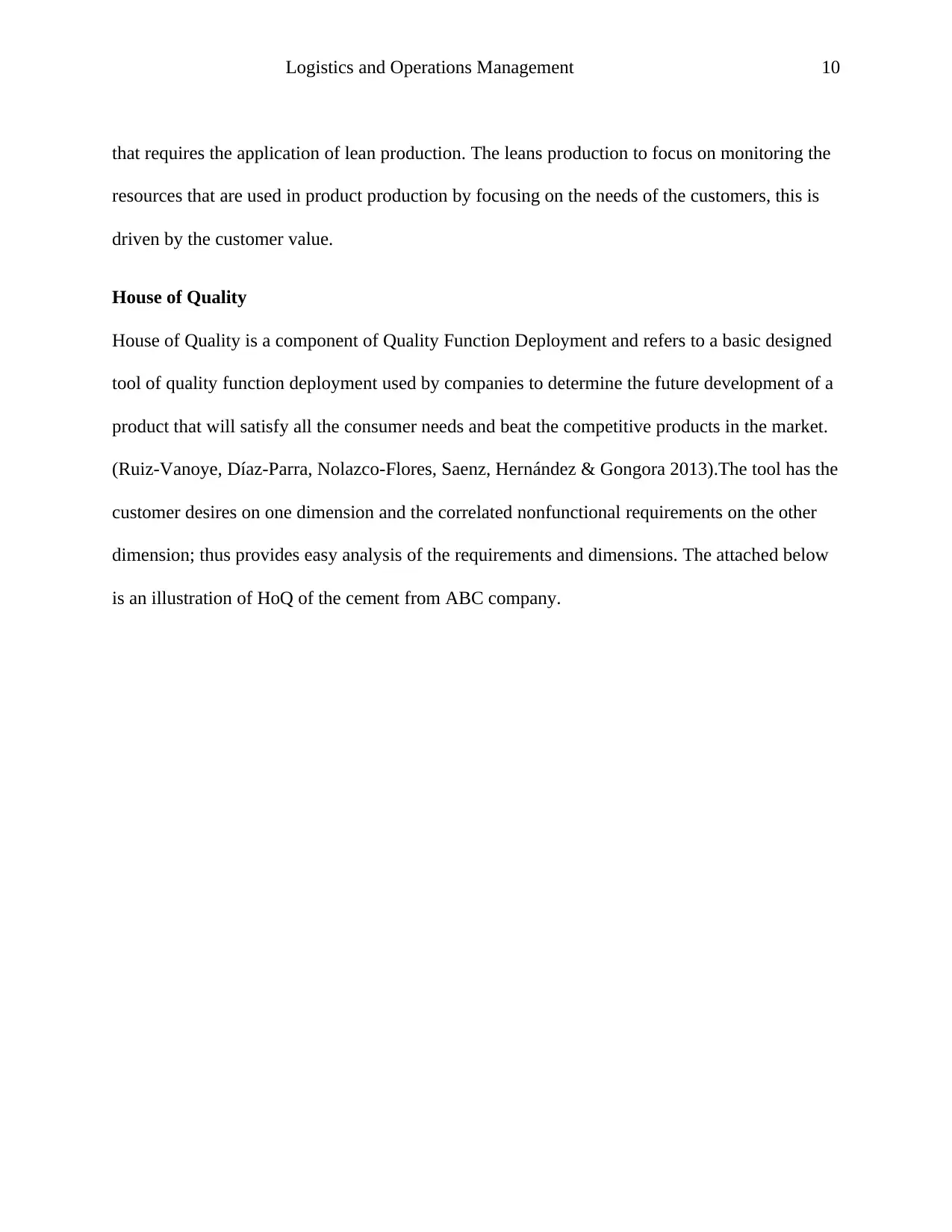
Logistics and Operations Management 10
that requires the application of lean production. The leans production to focus on monitoring the
resources that are used in product production by focusing on the needs of the customers, this is
driven by the customer value.
House of Quality
House of Quality is a component of Quality Function Deployment and refers to a basic designed
tool of quality function deployment used by companies to determine the future development of a
product that will satisfy all the consumer needs and beat the competitive products in the market.
(Ruiz-Vanoye, Díaz-Parra, Nolazco-Flores, Saenz, Hernández & Gongora 2013).The tool has the
customer desires on one dimension and the correlated nonfunctional requirements on the other
dimension; thus provides easy analysis of the requirements and dimensions. The attached below
is an illustration of HoQ of the cement from ABC company.
that requires the application of lean production. The leans production to focus on monitoring the
resources that are used in product production by focusing on the needs of the customers, this is
driven by the customer value.
House of Quality
House of Quality is a component of Quality Function Deployment and refers to a basic designed
tool of quality function deployment used by companies to determine the future development of a
product that will satisfy all the consumer needs and beat the competitive products in the market.
(Ruiz-Vanoye, Díaz-Parra, Nolazco-Flores, Saenz, Hernández & Gongora 2013).The tool has the
customer desires on one dimension and the correlated nonfunctional requirements on the other
dimension; thus provides easy analysis of the requirements and dimensions. The attached below
is an illustration of HoQ of the cement from ABC company.
Paraphrase This Document
Need a fresh take? Get an instant paraphrase of this document with our AI Paraphraser
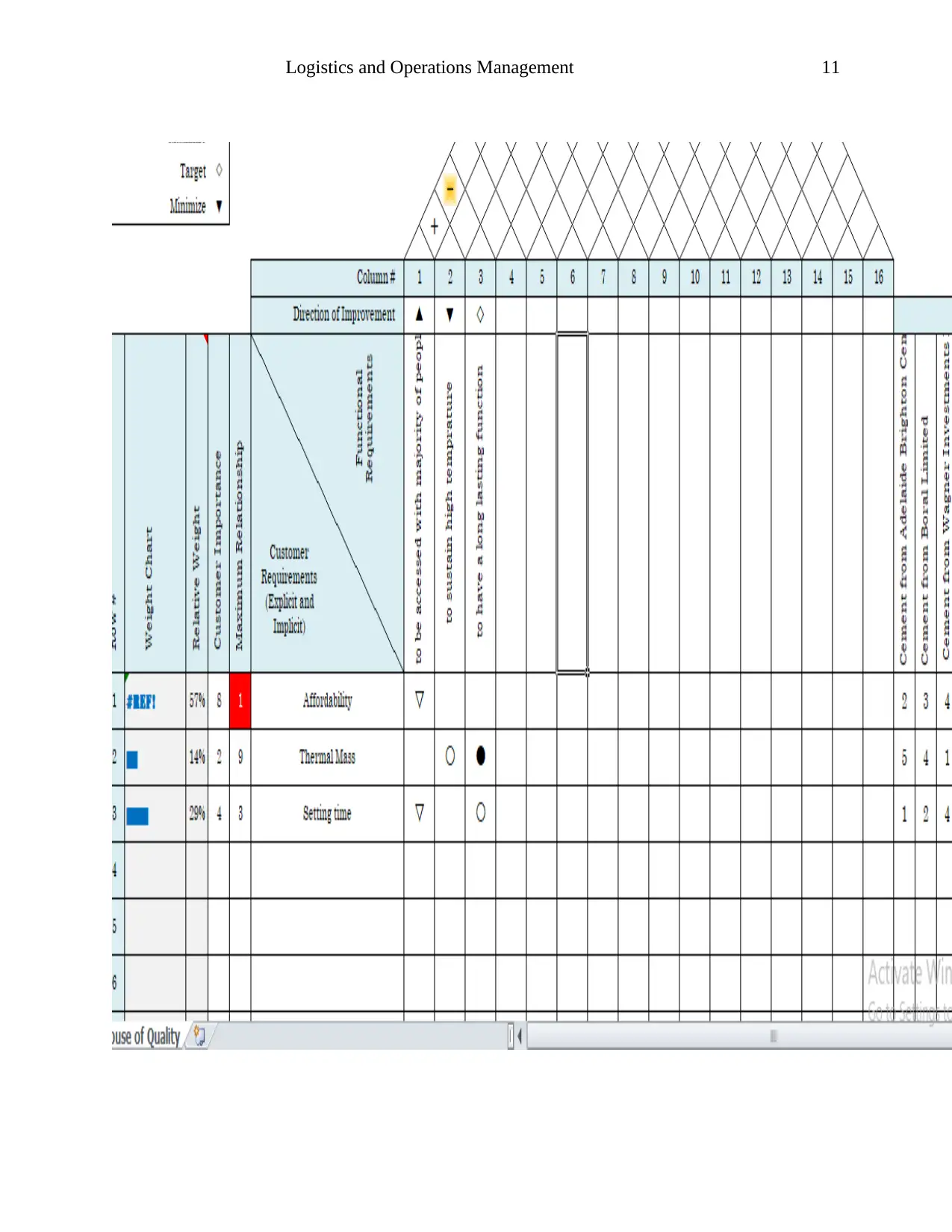
Logistics and Operations Management 11
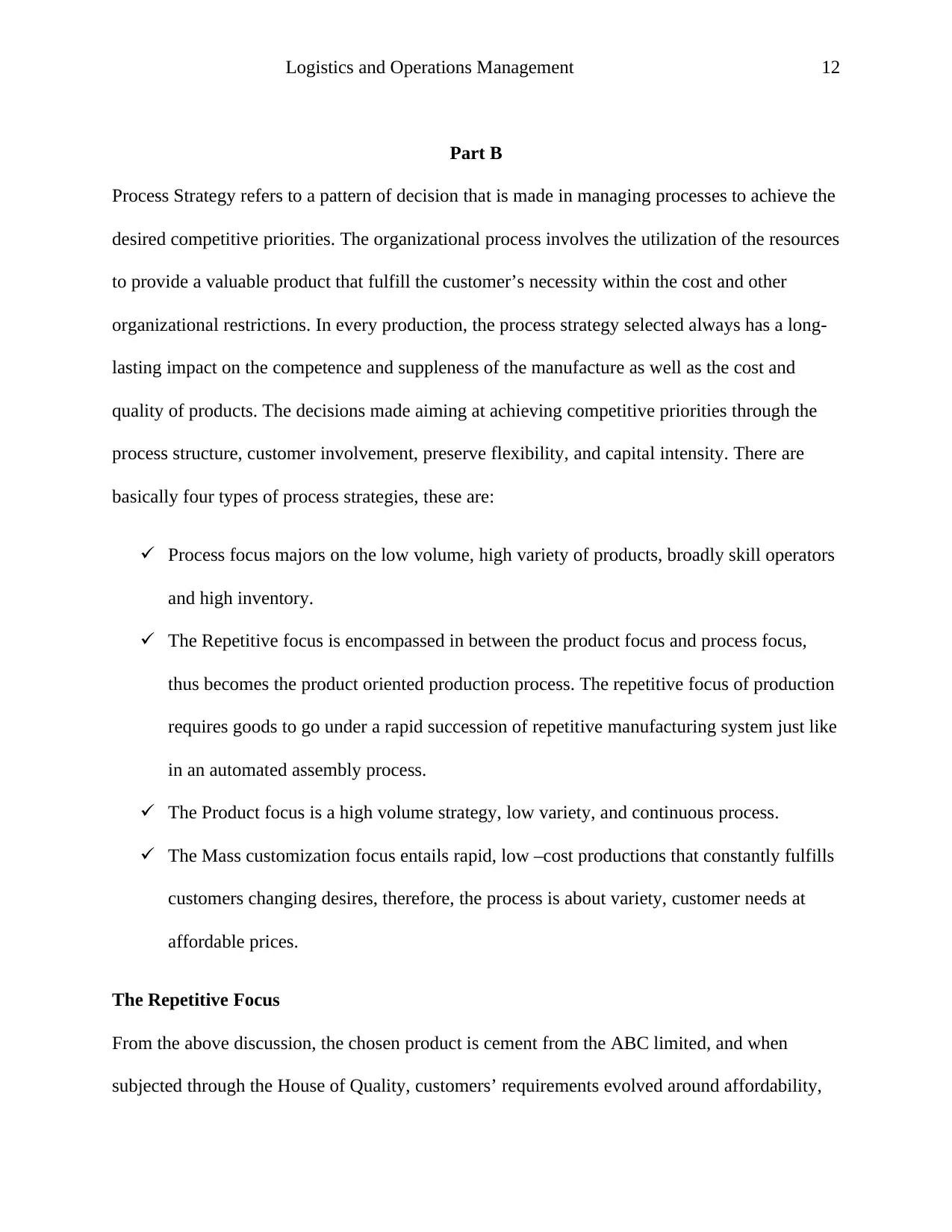
Logistics and Operations Management 12
Part B
Process Strategy refers to a pattern of decision that is made in managing processes to achieve the
desired competitive priorities. The organizational process involves the utilization of the resources
to provide a valuable product that fulfill the customer’s necessity within the cost and other
organizational restrictions. In every production, the process strategy selected always has a long-
lasting impact on the competence and suppleness of the manufacture as well as the cost and
quality of products. The decisions made aiming at achieving competitive priorities through the
process structure, customer involvement, preserve flexibility, and capital intensity. There are
basically four types of process strategies, these are:
Process focus majors on the low volume, high variety of products, broadly skill operators
and high inventory.
The Repetitive focus is encompassed in between the product focus and process focus,
thus becomes the product oriented production process. The repetitive focus of production
requires goods to go under a rapid succession of repetitive manufacturing system just like
in an automated assembly process.
The Product focus is a high volume strategy, low variety, and continuous process.
The Mass customization focus entails rapid, low –cost productions that constantly fulfills
customers changing desires, therefore, the process is about variety, customer needs at
affordable prices.
The Repetitive Focus
From the above discussion, the chosen product is cement from the ABC limited, and when
subjected through the House of Quality, customers’ requirements evolved around affordability,
Part B
Process Strategy refers to a pattern of decision that is made in managing processes to achieve the
desired competitive priorities. The organizational process involves the utilization of the resources
to provide a valuable product that fulfill the customer’s necessity within the cost and other
organizational restrictions. In every production, the process strategy selected always has a long-
lasting impact on the competence and suppleness of the manufacture as well as the cost and
quality of products. The decisions made aiming at achieving competitive priorities through the
process structure, customer involvement, preserve flexibility, and capital intensity. There are
basically four types of process strategies, these are:
Process focus majors on the low volume, high variety of products, broadly skill operators
and high inventory.
The Repetitive focus is encompassed in between the product focus and process focus,
thus becomes the product oriented production process. The repetitive focus of production
requires goods to go under a rapid succession of repetitive manufacturing system just like
in an automated assembly process.
The Product focus is a high volume strategy, low variety, and continuous process.
The Mass customization focus entails rapid, low –cost productions that constantly fulfills
customers changing desires, therefore, the process is about variety, customer needs at
affordable prices.
The Repetitive Focus
From the above discussion, the chosen product is cement from the ABC limited, and when
subjected through the House of Quality, customers’ requirements evolved around affordability,
⊘ This is a preview!⊘
Do you want full access?
Subscribe today to unlock all pages.

Trusted by 1+ million students worldwide
1 out of 24
Related Documents
Your All-in-One AI-Powered Toolkit for Academic Success.
+13062052269
info@desklib.com
Available 24*7 on WhatsApp / Email
![[object Object]](/_next/static/media/star-bottom.7253800d.svg)
Unlock your academic potential
Copyright © 2020–2025 A2Z Services. All Rights Reserved. Developed and managed by ZUCOL.





